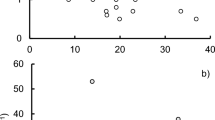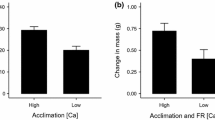Abstract
Increasing input of terrestrial dissolved organic carbon (DOC) has been identified as a widespread environmental phenomenon in many aquatic ecosystems. Terrestrial DOC influences basal trophic levels: it can subsidize pelagic bacterial production and impede benthic primary production via light attenuation. However, little is known about the impacts of elevated DOC concentrations on higher trophic levels, especially on top consumers. Here, we used Eurasian perch (Perca fluviatilis) to investigate the effects of increasing DOC concentrations on top predator populations. We applied stable isotope analysis and geometric morphometrics to estimate long-term resource and habitat utilization of perch. Habitat coupling, the ability to exploit littoral and pelagic resources, strongly decreased with increasing DOC concentrations due to a shift toward feeding predominantly on pelagic resources. Simultaneously, resource use and body morphology became increasingly alike for littoral and pelagic perch populations with increasing DOC, suggesting more intense competition in lakes with high DOC. Eye size of perch increased with increasing DOC concentrations, likely as a result of deteriorating visual conditions, suggesting a sensory response to environmental change. Increasing input of DOC to aquatic ecosystems is a common result of environmental change and might affect top predator populations in multiple and complex ways.



Similar content being viewed by others
References
Ask J, Karlsson J, Persson L, Ask P, Byström P, Jansson M. 2009. Terrestrial organic matter and light penetration: effects on bacterial and primary production in lakes. Limnol Oceanogr 54:2034–40.
Bartels P, Hirsch PE, Svanbäck R, Eklöv P. 2012. Water transparency drives intra-population divergence in Eurasian perch (Perca fluviatilis). PLoS One 7:e43641.
Batschelet E. 1981. Circular Statistics in Biology. London: Academic Press.
Bolnick DI, Svanbäck R, Fordyce JA, Yang LH, Davis JM, Hulsey CD, Forister ML. 2003. The ecology of individuals: incidence and implications of individual specialization. Am Nat 161:1–28.
Briand F, Cohen JE. 1987. Environmental correlates of food-chain length. Science 238:956–60.
Bukaveckas PA, Robbins-Forbes M. 2000. Role of dissolved organic carbon in the attenuation of photosynthetically active and ultraviolet radiation in Adirondack lakes. Freshw Biol 43:339–54.
Carter MW, Shoup DE, Dettmers JM, Wahl DH. 2010. Effects of turbidity and cover on prey selectivity of adult smallmouth bass. Trans Am Fish Soc 139:353–61.
Clark JM, Bottrell SH, Evans CD, Monteith DT, Bartlett R, Rose R, Newton RJ, Chapman PJ. 2010. The importance of the relationship between scale and process in understanding long-term DOC dynamics. Sci Total Environ 408:2768–75.
Craig N, Jones SE, Weidel BC, Solomon CT. 2015. Habitat, not resource availability, limits consumer production in lake ecosystems. Limnol Oceanogr 60:2079–89.
Dolson R, McCann K, Rooney N, Ridgway M. 2009. Lake morphometry predicts the degree of habitat coupling by a mobile predator. Oikos 118:1230–8.
Downing JA, Prairie YT, Cole JJ, Duarte CM, Tranvik LJ, Striegl RG, McDowell WH, Kortelainen P, Caraco NF, Melack JM, Middelburg JJ. 2006. The global abundance and size distribution of lakes, ponds, and impoundments. Limnol Oceanogr 51:2388–97.
Drinan TJ, McGinnity P, Coughlan JP, Cross TF, Harrison SSC. 2012. Morphological variability of Atlantic salmon Salmo salar and brown trout Salmo trutta in different river environments. Ecol Freshw Fish 21:420–32.
Duffy MA. 2010. Ecological consequences of intraspecific variation in lake Daphnia. Freshw Biol 55:995–1004.
Ehlinger T, Wilson D. 1988. Complex foraging polymorphism in bluegill sunfish. Proc Natl Acad Sci USA 85:1878–82.
Eklöv P, Svanbäck R. 2006. Predation risk influences adaptive morphological variation in fish populations. Am Nat 167:440–52.
Von der Emde G, Mogdans J, Kapoor BG. 2004. The senses of fish: adaptations for the reception of natural stimuli. The Netherlands: Springer.
Estlander S, Nurminen L, Olin M, Vinni M, Immonen S, Rask M, Ruuhijarvi J, Horppila J, Lehtonen H. 2010. Diet shifts and food selection of perch Perca fluviatilis and roach Rutilus rutilus in humic lakes of varying water colour. J Fish Biol 77:241–56.
Finstad AG, Helland IP, Ugedal O, Hesthagen T, Hessen DO. 2014. Unimodal response of fish yield to dissolved organic carbon. Ecol Lett 17:36–43.
Ganz HH, Ebert D. 2010. Benefits of host genetic diversity for resistance to infection depend on parasite diversity. Ecology 91:1263–8.
Gregory RS, Northcote TG. 1993. Surface, planktonic, and benthic foraging by juvenile Chinook salmon (Oncorhynchus tshawytscha) in turbid laboratory conditions. Can J Fish Aquat Sci 50:233–40.
Hampton SE, Fradkin SC, Leavitt PR, Rosenberger EE. 2011. Disproportionate importance of nearshore habitat for the food web of a deep oligotrophic lake. Mar Freshw Res 62:350–8.
Harvey BC, White JL. 2008. Use of benthic prey by salmonids under turbid conditions in a laboratory stream. Trans Am Fish Soc 137:1756–63.
Herberich E, Sikorski J, Hothorn T. 2010. A robust procedure for comparing multiple means under heteroscedasticity in unbalanced designs. PLoS One 5:e9788.
Hjelm J, Svanbäck R, Byström P, Persson L, Wahlström E. 2001. Diet-dependent body morphology and ontogentic reaction norms in Eurasian perch. Oikos 95:311–23.
Hobson KA, Clark RG. 1992. Assessing avian diets using stable isotopes I: Turnover of 13C in tissues. Condor 94:181–8.
Jackson AL, Inger R, Parnell AC, Bearhop S. 2011. Comparing isotopic niche widths among and within communities: SIBER—Stable Isotope Bayesian Ellipses in R. J Anim Ecol 80:595–602.
Jones R. 1992. The influence of humic substances on lacustrine planktonic food-chains. Hydrobiologia 229:73–91.
Karlsson J, Byström P. 2005. Littoral energy mobilization dominates energy supply for top consumers in subarctic lakes. Limnol Oceanogr 50:538–43.
Karlsson J, Byström P, Ask J, Ask P, Persson L, Jansson M. 2009. Light limitation of nutrient-poor lake ecosystems. Nature 460:506–9.
Kelly PT, Solomon CT, Weidel BC, Jones SE. 2014. Terrestrial carbon is a resource, but not a subsidy, for lake zooplankton. Ecology 95:1236–42.
Kent C, Wong J. 1982. An index of littoral-zone complexity and its measurement. Can J Fish Aquat Sci 39:847–53.
Layman CA, Arrington DA, Montana CG, Post DM. 2007. Can stable isotope ratios provide for community-wide measures of trophic structure? Ecology 88:42–8.
Monteith DT, Stoddard JL, Evans CD, de Wit HA, Forsius M, Hogasen T, Wilander A, Skjelkvale BL, Jeffries DS, Vuorenmaa J, Keller B, Kopacek J, Vesely J. 2007. Dissolved organic carbon trends resulting from changes in atmospheric deposition chemistry. Nature 450:537–40.
Northcote D, Volkman F, Yager D. 1978. Vision in fishes: color and pattern. In: Mostotsky D, Ed. The behavior of fish and other aquatic animals. New York: Academic Press. p 79–136.
Oksanen L, Fretwell SD, Arruda J, Niemela P. 1981. Exploitation ecosystems in gradients of primary productivity. Am Nat 118:240–61.
Olsson J, Svanbäck R, Eklöv P. 2006. Growth rate constrain morphological divergence when driven by competition. Oikos 115:15–22.
Parnell AC, Inger R, Bearhop S, Jackson AL. 2010. Source partitioning using stable isotopes: coping with too much variation. PLoS One 5:e9672.
Persson L, Byström P, Wahlström E. 2000. Cannibalism and competition in Eurasian perch: population dynamics of an ontogenetic omnivore. Ecology 81:1058–71.
Persson L, De Roos AM, Claessen D, Byström P, Lövgren J, Sjögren S, Svanbäck R, Wahlström E, Westman E. 2003. Gigantic cannibals driving a whole-lake trophic cascade. Proc Natl Acad Sci 100:4035–9.
Phillips DL, Gregg JW. 2001. Uncertainty in source partitioning using stable isotopes. Oecologia 127:171–9.
Pinnegar JK, Polunin NVC. 1999. Differential fractionation of δ13C and δ15N among fish tissues: implications for the study of trophic interactions. Funct Ecol 13:225–31.
Polis GA, Anderson WB, Holt RD. 1997. Toward an integration of landscape and food web ecology: the dynamics of spatially subsidized food webs. Annu Rev Ecol Syst 28:289–316.
Post DM. 2002. Using stable isotopes to estimate trophic position: models, methods, and assumptions. Ecology 83:703–18.
Post DM, Layman CA, Arrington DA, Takimoto G, Quattrochi J, Montana CG. 2007. Getting to the fat of the matter: models, methods and assumptions for dealing with lipids in stable isotope analyses. Oecologia 152:179–89.
Premke K, Karlsson J, Steger K, Gudasz C, von Wachenfeldt E, Tranvik LJ. 2010. Stable isotope analysis of benthic fauna and their food sources in boreal lakes. J N Am Benthol Soc 29:1339–48.
Quevedo M, Svanbäck R, Eklöv P. 2009. Intrapopulation niche partitioning in a generalist predator limits food web connectivity. Ecology 90:2263–74.
R Core Team. 2014. R: a language and environment for statistical computing. Vienna, Austria: R Foundation for Statistical Computing. http://111.r-project.org/.
Ranåker L, Jönsson M, Nilsson PA, Brönmark C. 2012. Effects of brown and turbid water on piscivore-prey fish interactions along a visibility gradient. Freshw Biol 57:1761–8.
Rooney N, McCann K, Gellner G, Moore JC. 2006. Structural asymmetry and the stability of diverse food webs. Nature 442:265–9.
Rooney N, McCann KS, Moore JC. 2008. A landscape theory for food web architecture. Ecol Lett 11:867–81.
Schindler DE, Scheuerell MD. 2002. Habitat coupling in lake ecosystems. Oikos 98:177–89.
Seekell DA, Lapierre J-F, Ask J, Bergström A-K, Deininger A, Rodriguez P, Karlsson J. 2015. The influence of dissolved organic carbon on primary production in northern lakes. Limnol Oceanogr 60:1276–85.
Smith TB, Skúlason S. 1996. Evolutionary significance of resource polymorphisms in fishes, amphibians, and birds. Annu Rev Ecol Syst 27:111–33.
Solomon CT, Jones SE, Weidel BC, Buffam I, Fork ML, Karlsson J, Larsen S, Lennon JT, Read JS, Sadro S, Saros JE. 2015. Ecosystem consequences of changing inputs of terrestrial dissolved organic matter to lakes: current knowledge and future challenges. Ecosystems 18:376–89.
Svanbäck R, Eklöv P. 2002. Effects of habitat and food resources on morphology and ontogenetic growth trajectories in perch. Oecologia 131:61–70.
Svanbäck R, Eklöv P. 2003. Morphology dependent foraging efficiency in perch: a trade-off for ecological specialization? Oikos 102:273–84.
Svanbäck R, Eklöv P. 2004. Morphology in perch affects habitat specific feeding efficiency. Funct Ecol 18:503–10.
Svanbäck R, Eklöv P, Fransson R, Holmgren K. 2008. Intraspecific competition drives multiple species resource polymorphism in fish communities. Oikos 117:114–24.
Svanbäck R, Persson L. 2009. Population density fluctuations change the selection gradient in Eurasian perch. Am Nat 173:507–16.
Thomas SM, Crowther TW. 2015. Predicting rates of isotopic turnover across the animal kingdom: a synthesis of existing data. J Anim Ecol 84:861–70.
Tranvik L. 1988. Availability of dissolved organic carbon for planktonic bacteria in oligotrophic lakes of differing humic content. Microb Ecol 16:311–22.
Vadeboncoeur Y, McCann KS, Vander Zanden MJ, Rasmussen JB. 2005. Effects of multi-chain omnivory on the strength of trophic control in lakes. Ecosystems 8:682–93.
Vadeboncoeur Y, Peterson G, Vander Zanden MJ, Kalff J. 2008. Benthic algal production across lake size gradients: interactions among morphometry, nutrients, and light. Ecology 89:2542–52.
Vadeboncoeur Y, Vander Zanden MJ, Lodge DM. 2002. Putting the lake back together: reintegrating benthic pathways into lake food web models. Bioscience 52:44–54.
Vander Zanden MJ, Vadeboncoeur Y. 2002. Fishes as integrators of benthic and pelagic food webs in lakes. Ecology 83:2152–61.
Vander Zanden MJ, Vadeboncoeur Y, Chandra S. 2011. Fish reliance on littoral-benthic resources and the distribution of primary production in lakes. Ecosystems 14:894–903.
Zelditch M, Swiderski D, Sheets H, Fink W. 2004. Geometric morphometrics for biologists. Burlington: Elsevier Academic Press Inc.
Acknowledgements
We thank J Malmberg, E Geibrink, M Puffer, M Möst, and A Klaussén for help in the field and in the lab and the two anonymous reviewers for their highly valuable comments on a previous version of the manuscript. This study was financed by grants from the Swedish Research Council for Environment, Agricultural Sciences, and Spatial Planning (FORMAS) to PB and PE, the Swedish Research Council (VR) to PE and RS, the Uppsala Graduate School to PEH, and the Malmén´s Foundation to PB and PEH.
Author information
Authors and Affiliations
Corresponding author
Additional information
Authors’ contribution
Pia Bartels and Peter Eklöv conceived, designed, and conducted the study. Philipp Emanuel Hirsch and Richard Svanbäck contributed data. Pia Bartels analyzed the data and wrote the manuscript. All authors contributed substantially to the final version of the manuscript.
Electronic supplementary material
Below is the link to the electronic supplementary material.
Rights and permissions
About this article
Cite this article
Bartels, P., Hirsch, P.E., Svanbäck, R. et al. Dissolved Organic Carbon Reduces Habitat Coupling by Top Predators in Lake Ecosystems. Ecosystems 19, 955–967 (2016). https://doi.org/10.1007/s10021-016-9978-x
Received:
Accepted:
Published:
Issue Date:
DOI: https://doi.org/10.1007/s10021-016-9978-x




